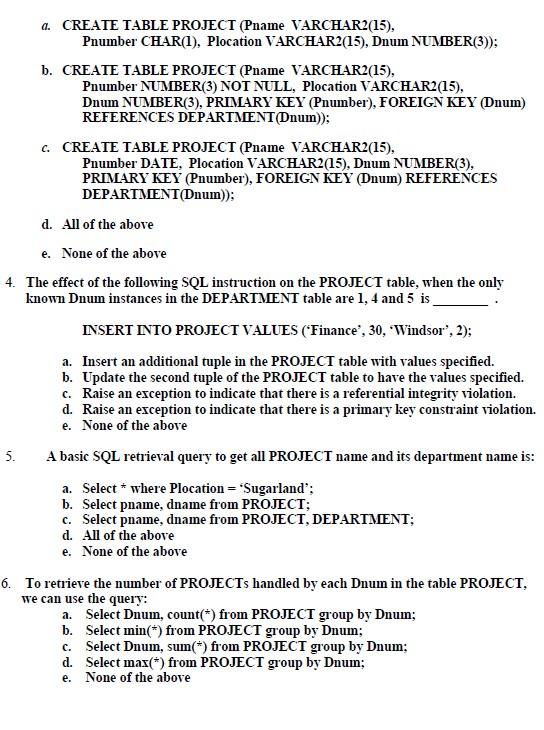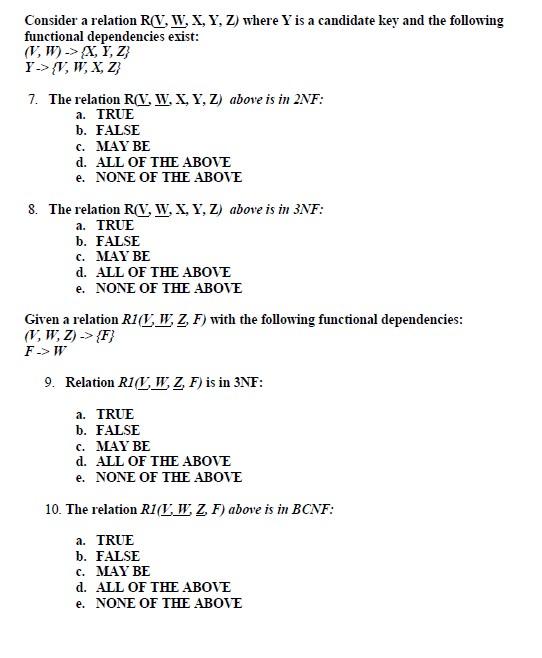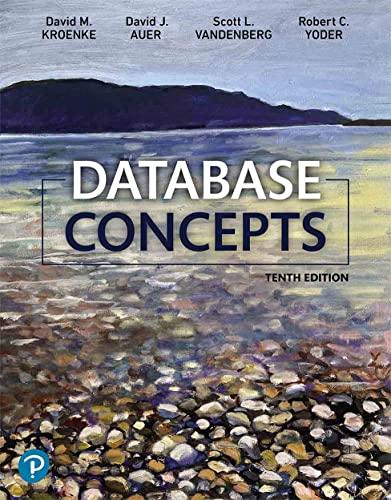


For Questions 1-10, circle the most correct answer for each question. Given the following relation table state for PROJECT, where Pnumber is the primary key and Dnum refers to Dnum in another relation DEPARTMENT(Dnum, Dname), use it to answer the next few applicable questions. PROJECT Pname Pnumber Plocation Dnum ProductX 10 Bellaire 5 ProductY 11 Sugarland 5 Productz 12 Houston 5 Computerize 20 Stafford 4 Houston 5 Reorganize 40 Newbenefits 50 Stafford 4 Fig. 1: Table Project 1. Which of the following statements is correct about the table PROJECT? a. Pnumber {Pname, Plocation, Dnum) is a functional dependency b. Dnum Plocation is a functional dependency c. Dnum Pnumber is a functional dependency d. all of the above e. none of the above. 2. In Fig. 1, the relation Project is in a. BCNF. b. 3NF. c. 2NF. d. all of the above. e none of the above. 3. Which of the following create table command is given most correctly for creating the table PROJECT? a. CREATE TABLE PROJECT (Pname VARCHAR2(15), Pnumber CHAR(I), Plocation VARCHAR2(15), Dnum NUMBER(3)); b. CREATE TABLE PROJECT (Pname VARCHAR2(15), Pnumber NUMBER(3) NOT NULL, Plocation VARCHAR2(15), Dnum NUMBER(3), PRIMARY KEY (Pnumber), FOREIGN KEY (Dnum) REFERENCES DEPARTMENT(Dnum)); C. CREATE TABLE PROJECT (Pname VARCHAR2(15), Pnumber DATE, Plocation VARCHAR2(15), Dnum NUMBER(3), PRIMARY KEY (Pnumber), FOREIGN KEY (Dnum) REFERENCES DEPARTMENT(Dnum)); d. All of the above e. None of the above 4. The effect of the following SQL instruction on the PROJECT table, when the only known Dnum instances in the DEPARTMENT table are 1, 4 and 5 is INSERT INTO PROJECT VALUES ("Finance", 30, Windsor', 2); a. Insert an additional tuple in the PROJECT table with values specified. b. Update the second tuple of the PROJECT table to have the values specified. c. Raise an exception to indicate that there is a referential integrity violation. d. Raise an exception to indicate that there is a primary key constraint violation. e. None of the above 5. A basic SQL retrieval query to get all PROJECT name and its department name is: a. Select * where Plocation = 'Sugarland': b. Select pname, dname from PROJECT; c. Select pname, dname from PROJECT, DEPARTMENT; d. All of the above e. None of the above 6. To retrieve the number of PROJECTs handled by each Dnum in the table PROJECT, we can use the query: a. Select Dnum, count(*) from PROJECT group by Dnum; b. Select min(*) from PROJECT group by Dnum; c. Select Dnum, sum(*) from PROJECT group by Dnum; d. Select max(*) from PROJECT group by Dnum; e. None of the above Consider a relation RCV, W, X, Y, Z) where Y is a candidate key and the following functional dependencies exist: (VW) -> A,1,Z} Y->{V, W, X, Z 7. The relation RV, W, X, Y, Z) above is in 2NF: a. TRUE b. FALSE c. MAY BE d. ALL OF THE ABOVE e. NONE OF THE ABOVE 8. The relation R(V, W, X, Y, Z) above is in 3NF: a. TRUE b. FALSE c. MAY BE d. ALL OF THE ABOVE e. NONE OF THE ABOVE Given a relation RICW, Z, F) with the following functional dependencies: (V, W,) -> {F} F->W 9. Relation RICW, Z F) is in 3NF: a. TRUE b. FALSE c. MAY BE d. ALL OF THE ABOVE e. NONE OF THE ABOVE 10. The relation RIC, W.Z, F) above is in BCNF: a. TRUE b. FALSE C. MAY BE d. ALL OF THE ABOVE e. NONE OF THE ABOVE









